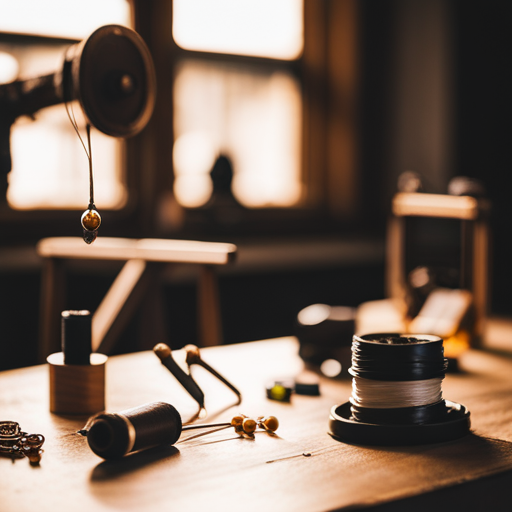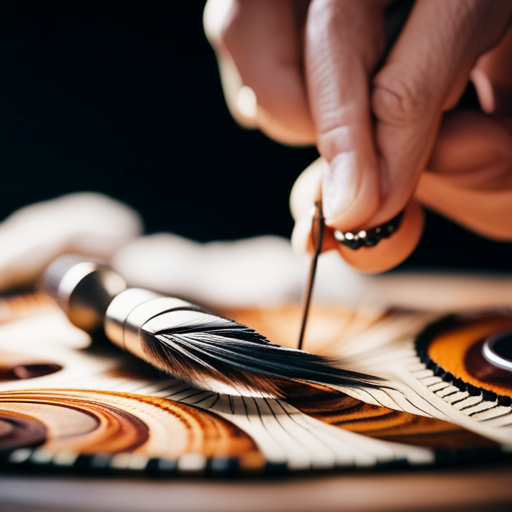Dive into the art of streamer fly tying with our comprehensive guide, ‘Streamer Fly Tying: Techniques and Tips.’
From selecting the finest materials to mastering intricate tying techniques, this article is your go-to resource for honing your fly-tying skills.
Gain insights into troubleshooting common issues and learn pro tips for creating lifelike patterns.
Whether you’re a novice or experienced fly tyer, this article will elevate your streamer fly tying game to new heights.
Essential Tools for Streamer Fly Tying
When engaging in streamer fly tying, having essential tools such as a vise, scissors, and a bobbin is crucial for achieving precise and professional results. Proper hook selection and sizing are also fundamental for creating well-balanced and effective streamer flies. To ensure the tools remain in optimal condition, regular maintenance is essential. Keeping scissors sharp, lubricating the vise, and periodically cleaning the bobbin are vital for efficient fly tying. Additionally, organizing the tools in a designated fly tying area contributes to a seamless tying process.
Proper hook selection is crucial as it directly impacts the fly’s action, balance, and overall effectiveness. Different streamer patterns may require varying hook sizes and styles, making it important to have a diverse selection available. Understanding the anatomy of a fly hook and its sizing system is imperative for choosing the right hook for a specific pattern. An organized hook storage system not only helps in selecting the right hook quickly but also aids in maintaining an orderly fly tying area, enhancing overall efficiency and enjoyment of the tying process.
Choosing the Right Materials
To ensure the precise construction and balanced action of streamer flies, a diverse selection of high-quality materials is essential for achieving professional results. Material selection plays a crucial role in determining the overall appearance and performance of the fly. When choosing materials, color coordination is important for creating a natural and enticing look that mimics the prey of the targeted fish. Texture manipulation is another key consideration, as it allows for the creation of realistic imitations of natural food sources. Additionally, weight distribution is critical for achieving the desired sink rate and movement in the water.
| Material Type | Characteristics | Commonly Used For |
|---|---|---|
| Marabou Feathers | Soft, lifelike movement | Woolly Buggers, Leeches |
| Flashabou | Reflective, flashy | Minnow Patterns |
| Deer Hair | Buoyant, water-resistant | Muddler Minnows |
| Lead Wire | Adds weight | Weighted Streamers |
Techniques for Adding Movement
One essential technique for adding movement to streamer flies is the strategic placement of weighted materials to achieve lifelike swimming action in the water. Material selection plays a crucial role in creating lifelike action, and certain materials such as lead wire, bead chains, or weighted eyes can be strategically incorporated into the fly’s design to enhance its movement.
Moreover, movement techniques like the use of articulated patterns can add a natural and realistic swimming motion to the fly. By incorporating articulation methods such as the use of junction tubing or flexible wire, the fly gains the ability to move in a more natural and fluid manner, mimicking the motion of live prey in the water.
It’s important to consider the weight distribution and placement of these materials to ensure that the fly moves in a manner that entices predatory fish. By understanding and implementing these techniques, fly tyers can create streamer flies that exhibit lifelike movement, making them more effective in attracting and enticing fish.
Pro Tips for Creating Realistic Patterns
Creating realistic patterns for streamer flies requires attention to detail and precision in material selection and placement. To achieve lifelike imitations, anglers can employ artistic techniques to mimic natural prey effectively. Here are some pro tips for creating realistic streamer patterns:
| Artistic Technique | Description | Example Materials |
|---|---|---|
| Layering | Build depth and dimension for a natural look | Marabou, Flashabou |
| Veiling | Create a translucent effect for realism | Krystal Flash, Organza |
| Color Blending | Blend colors to match the natural environment | Rabbit Strips, Ice Dub |
| Natural Movement | Incorporate materials that move naturally | Ostrich Herl, Soft Hackle |
Understanding Streamer Fly Design
Understanding the design of streamer flies involves a careful consideration of their anatomy and the effective color combinations.
By understanding the anatomy, fly tyers can create patterns that mimic the natural movement and appearance of prey, enticing more strikes from fish.
Additionally, choosing the right color combinations can greatly enhance the effectiveness of streamer flies in different water and light conditions.
Streamer Fly Anatomy
An essential aspect of streamer fly design involves a detailed understanding of streamer fly anatomy. This understanding is crucial for creating effective and realistic imitations of baitfish or other aquatic creatures. When considering the anatomy of a streamer fly, several key elements should be taken into account:
-
Streamlined Profile: The overall shape of the fly should mimic the natural silhouette of the prey it imitates, allowing it to move through the water with minimal resistance.
-
Weighted Head: Incorporating weight into the head of the fly helps it sink properly and imparts lifelike movement.
-
Anatomical Features: Including anatomically accurate features such as fins, tails, and eyes can enhance the fly’s realism and attractiveness to fish.
-
Material Selection: Choosing the right materials for body, wing, and tail construction is essential for achieving the desired movement and appearance.
Understanding these elements is crucial for designing effective streamer flies that entice fish to strike.
Effective Color Combinations
Continuing the exploration of streamer fly design, the selection of effective color combinations plays a crucial role in attracting the attention of fish and eliciting strikes. Understanding color theory and its application to fly patterns is essential for creating successful streamer designs.
When considering color combinations, it’s important to weigh the benefits of natural versus synthetic materials. Natural materials can provide a more realistic appearance, while synthetic materials offer a broader range of vibrant and durable color options. Material selection also impacts how colors appear underwater, as some materials may appear differently when wet.
Experimenting with different color combinations and materials can help fly tyers find the most effective patterns for specific fishing conditions and target species. Ultimately, a thoughtful understanding of color theory and material selection is key to creating streamer flies that consistently attract and entice fish.
Troubleshooting Common Tying Issues
Now, let’s address some common tying issues that can arise during streamer fly tying.
Correcting thread tension, fixing feather placement, and adjusting hook size are all important troubleshooting techniques that can greatly improve the quality and effectiveness of your streamer flies.
Correcting Thread Tension
Adequate thread tension is crucial for successful streamer fly tying, as it ensures proper material placement and secure wraps. Improving tension and mastering thread control can be challenging, but with practice and attention to detail, it can be achieved.
Here are four tips to help correct thread tension issues:
-
Adjust Tension: Experiment with the amount of pressure applied to the thread to find the optimal tension for different materials.
-
Use Bobbin Holder: Utilize a bobbin holder to maintain consistent tension and prevent excessive slack or tightness in the thread.
-
Practice Control: Develop a smooth and steady hand movement to control the thread’s tension throughout the tying process.
-
Select the Right Thread: Choose the appropriate thread weight and material for the specific fly pattern to ensure proper tension and secure wraps.
Fixing Feather Placement
To address feather placement issues when tying streamer flies, it is essential to maintain steady thread tension and precise material placement throughout the process. Troubleshooting feather placement issues can often be resolved through careful feather manipulation and positioning.
When encountering problems with feather placement, adjust the tension of the thread to hold the feathers in place securely without causing them to shift or become misaligned. Additionally, ensure that the feathers are positioned correctly on the hook shank before securing them with thread wraps.
By carefully manipulating the feathers and positioning them with precision, fly tyers can effectively address common feather placement issues and produce well-balanced and visually appealing streamer flies.
Consistent attention to feather placement and the use of troubleshooting techniques will lead to improved fly tying results.
Adjusting Hook Size
When troubleshooting common tying issues, adjusting the hook size can significantly impact the overall balance and proportion of streamer flies. This adjustment can be crucial in achieving the desired action and sink rate.
Here are some important considerations when modifying hook size:
-
Proportion: A larger hook may require additional materials to maintain proper proportions, while a smaller hook may necessitate reducing material volume to prevent overcrowding.
-
Action: Changing the hook size can alter the fly’s action in the water, with larger hooks providing more resistance and smaller hooks allowing for increased mobility.
-
Sink Rate: Heavier hooks can affect the sink rate, making it necessary to adjust materials to achieve the desired depth.
-
Selecting Appropriate Materials: When modifying existing patterns for different hook sizes, it’s crucial to select materials that are suitable for the new proportions and weight distribution.
Finishing Touches and Presentation
How meticulously should streamer fly tiers pay attention to the finishing touches and presentation of their flies to ensure their effectiveness in enticing strikes? Presentation tips and final touches play a crucial role in the overall success of a streamer fly. When it comes to streamer fly display, finishing techniques are essential for creating a fly that not only looks appealing but also performs effectively in the water. Attention to detail is key in ensuring that the fly is well-balanced, durable, and visually attractive.
In terms of presentation tips, it’s essential to ensure that the materials are secured neatly and that the head and body of the fly are proportionate and well-constructed. Finishing techniques such as whip finishing and head cement application are vital for securing the tying thread and materials, adding to the fly’s durability. Additionally, carefully trimming and shaping materials can greatly enhance the overall appearance of the fly.
Frequently Asked Questions
How Do I Choose the Best Fishing Spot for Using Streamer Flies?
When choosing locations for using streamer flies, consider factors such as water depth, current speed, and structure. Look for areas with cover and where fish may be holding, such as near banks, submerged rocks, or changes in water flow.
What Are Some Common Mistakes Beginners Make When Tying Streamer Flies?
What are some common mistakes beginners make when tying streamer flies? Many beginners struggle with avoiding tangles and selecting the right materials for streamer fly design. It’s crucial to focus on technique and material choice to minimize errors.
Are There Any Specific Streamer Fly Patterns That Work Best for Different Types of Fish?
When considering streamer fly patterns, it is essential to account for fish preferences. Matching streamer flies to specific fish behavior is crucial. Different types of fish may respond best to particular streamer fly patterns, so it’s important to tailor your approach accordingly.
How Can I Effectively Fish With Streamer Flies in Different Water Conditions?
When fishing with streamer flies in different water conditions, effective casting techniques and retrieval methods are crucial. Varying weather conditions and water depth require adaptability. Utilize a slow retrieve in deeper water and adapt to faster currents in shallower areas.
What Are Some Advanced Techniques for Incorporating Natural Movement Into My Streamer Flies?
Incorporating natural movement into streamer flies involves advanced fly tying and animation techniques. By focusing on materials that mimic underwater action and experimenting with varying retrieve methods, anglers can achieve lifelike motion, attracting more strikes.
Conclusion
In conclusion, streamer fly tying requires a precise selection of tools and materials, as well as a deep understanding of design and movement techniques.
Troubleshooting common tying issues and adding finishing touches are essential to creating realistic and effective patterns.
The art of streamer fly tying is a delicate and intricate process, requiring patience and attention to detail in order to achieve a lifelike and captivating presentation.




